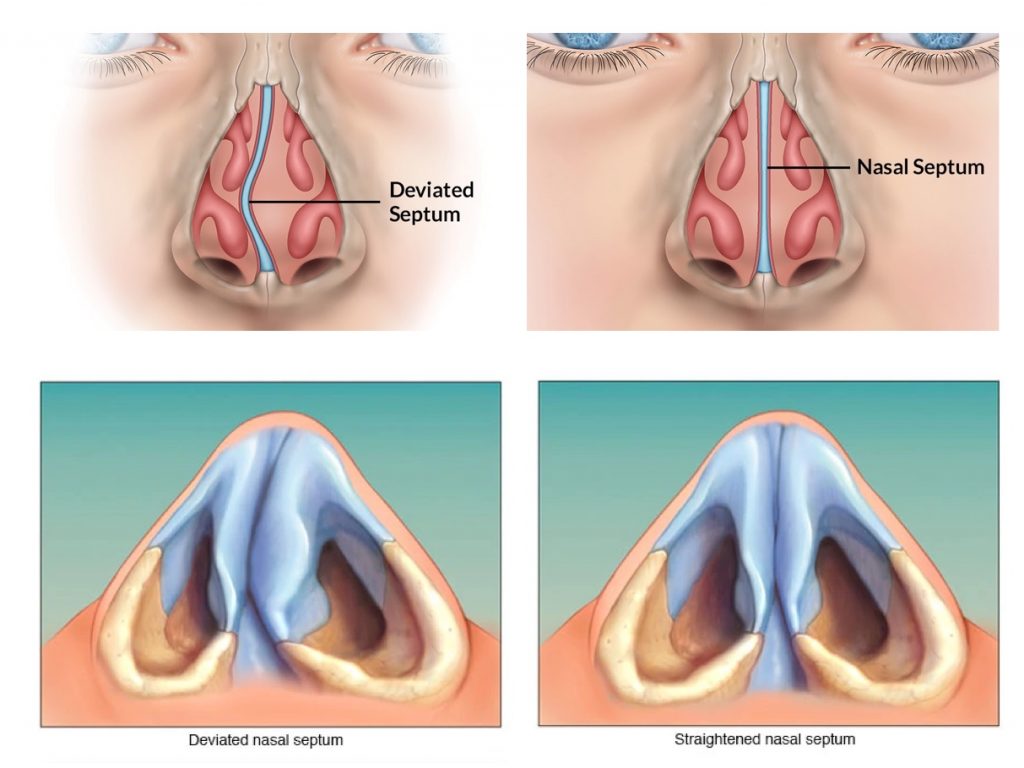Deviated Septum & Septoplasty Surgery in Sydney
What is a septoplasty?
A septoplasty is a procedure that corrects a problem with the nasal septum. The nasal septum is the wall between the left and right sides of the nose. It is firm, but bendable, and it is covered by skin that has a rich supply of blood vessels. Ideally, the nasal septum should lie exactly in the center, so that the left and right sides of the nose are of equal size. In about 80% of us, however, the nasal septum is a little off-center, although most of us never notice. Less often, the septum is more dramatically off-center. This is called a deviated septum.
The nasal septum may become bent or deviated from trauma or abnormal growth leading to a blockage nose on one or both sides. It may also simply grow in a bent fashion without a history of trauma.
A septoplasty treats the nasal septum which is the midline structure dividing the two nostrils into their halves. It contains cartilage and bone and both elements may need to be corrected.
Sometimes septoplasty is necessary to correct a bend in the nose which is visible on the outside as a cosmetic problem. If this is severe, it may be combined with a rhinoplasty and the procedure is called a septorhinoplasty.

Why would I need a septoplasty?
A septoplasty is a very common operation. It is most commonly performed to treat a blocked nose, sinusitis (a sinus infection, sinus) or to correct a cosmetic problem. A septoplasty may also be necessary to address nasal polyps, sinus headaches, post-nasal drip or nose bleeds.
An ear, nose and throat specialist will be able to help you decide if you need a septoplasty.
How is a bent septum diagnosed?
Patients usually complain of difficulty breathing through one side of the nose or both. This could have been gradually worsening over many years. They could also be snoring or have sleep apnoea.
The initial assessment is by nasal endoscopy in which a thin telescope is passed into each nostril to assess the deep nasal passages. In some patients, the telescope cannot be passed because the bent septum causes too much narrowing. Occasionally a CT scan is also needed, usually when patients have sinus problems as well as breathing problems.
What does the surgery involve?
A septoplasty is generally performed as day surgery. The operation takes around one hour to perform. In most cases an internal incision is made inside the nostril so that no scars are present on the outside. Very severe bends in the portion located near the nostrils may require a small external incision to correct.
The mucous membrane covering the cartilage and bone is first lifted. Bent cartilage and bone are straightened. Sometimes endoscopic (keyhole) instrumentation is used. Sometimes the septum may need to be reconstructed with cartilage grafts in order to provide adequate support of the nose once the bent areas have been corrected.
A certain amount of septal cartilage must be left in place to support the nasal tip and top of the nose. This could mean that the septum remains a little off centre. The aim is to make it sufficiently straight, not perfectly straight.
A septoplasty is frequently combined with a turbinoplasty procedure to improve airflow. The turbinates often enlarge and grow into the space left by a deviated septum. If this is not correct breathing will not return to normal.
The incision is closed at the end with dissolving stitches. Patients who have a very severe bend may require some soft splints to be left in place for 7 days during healing. Breathing is still possible around or through these splints.
A septoplasty is performed under general anaesthesia. Small splints are often need to be left in the nose after a septoplasty for one week. After a septoplasty, a single overnight stay in hospital may be necessary but not always. One week off work and two to three weeks off any heavy exercise is recommended.
Recovery after surgery
Initially you are taken to recovery where nursing staff will monitor you as you recover from your anaesthetic. Generally you will go home the same day. You will need to arrange for somebody to collect you from the hospital. If splints are used these are generally remove at around 7 days following surgery. Most people need 7 to 10 days off school or work and need to avoid heavy exercise for 3 weeks.
Who can perform a septoplasty?
An ear, nose and throat specialist can perform a septoplasty.
Septoplasty in children
Generally a septoplasty is deferred in children until they have finished growing. This is usually around the age of 16 in girls and 17 in boys, although all children are different. However, if symptoms are severe a septoplasty can be performed at any age. In these cases surgery is generally more conservative. Some children may need a slight revision operation when they are older and have finished growing.
Possible complications of surgery
General surgical risks
- Heavy bleeding may require a return to theatre (uncommon).
- Infection may require treatment with antibiotics.
- Short-term nausea following general anaesthesia, and other risks related to anaesthesia.
- Allergic reaction to sutures, dressings or antiseptic solutions.
- Uncommonly, complications such as deep vein thrombosis, heart attach, stroke or pulmonary embolism.
Specific Risks of septoplasty
- Abnormal bands of scar tissue (adhesions) may form across the nasal cavity within one or two weeks of surgery. Minor corrective surgery may be needed to remove them.
- Nasal stuffiness can still occur despite successful septoplasty because of swollen turbinates or other nasal problems such as allergies. Further treatment may be needed to address these problems.
- Perforation of the septum occurs in about one patient out of every 50. Most perforations do not cause symptoms. In some cases, symptoms may include bleeding, nasal crusting or a whistling noise when breathing through the nose. Surgical repair of a perforation is not always successful.
- A septoplasty may cause a saddle shaped dip on the front of the lower nose or drooping of the nose tip in about one patient in 500. Corrective surgery to improve the appearance of the nose tip may be needed.
- The central upper teeth may feel partially or completely numb. The nerve that supplies sensation to the upper teeth runs through the nose. Surgery can bruise or damage this nerve. Sensation usually returns within a few months.
- A blood clot may form beyond and deep to the incision site within the lining of the nose (septal haematoma). This may cause total blockage of both nostrils. Treatment includes surgery to drain the blood clot.
- A collection of pus may develop under the lining of the nose (septal abscess). This may occur as a complication of a septal haematoma. Symptoms include increasing pain, a red and tender nose, and fever. Treatment includes surgery to drain the abscess.
- Rarely, the patient’s sense of smell may be distorted, decreased or lost follow septoplasty.
- A cerebrospinal fluid (CSF) leak is a rare but serious complication caused by surgical damage to the roof of the nose that allows leakage of the CSF that surrounds the brain. There have been only a few reported cases in the medical literature. Surgery is often needed to repair the leak.
Download a copy of this information as an information sheet to print here – Septoplasty information sheet pdf
Dr Roth is an Ear, Nose and Throat surgeon with subspeciality training in the nose and sinuses. He is trained in the latest techniques in septoplasty.
About Dr Jason Roth, MBBS, FRACS

Dr Jason Roth is a Sydney ENT Specialist and Head & Neck Surgeon with Facial Plastic Surgery Fellowship training from Australia, the United States and Europe. He is an expert in Facelift Surgery, Rhinoplasty, Nose and Sinus Surgery.
He consults from his clinic in Dee Why and operates at several private hospitals across Sydney. Importantly, Dr Roth performs more than 300+ sinus and rhinoplasty surgeries per year, which makes him one of Sydney’s busiest nose and sinus surgeons. Dr Roth has exposure to a high volume of patients with both common and rare clinical problems, allowing him to develop a depth of expertise. View his full profile here.

